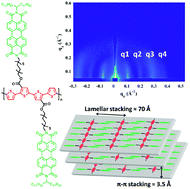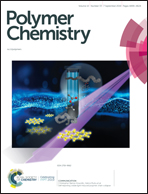Realizing lamellar nanophase separation in a double-cable conjugated polymer via a solvent annealing process†
Abstract
Single-component organic solar cells (OSCs) use one conjugated material as a photo-active layer, which can enhance the stability of cells and simplify the fabrication process compared to two-component OSCs. Among single-component conjugated materials, block conjugated polymers can form lamellar structures that are recognized as the ideal structures for OSCs, while it is difficult to tune the nanophase separation in double-cable conjugated polymers. In this work, for the first time, we show that, by rationally designing chemical structures and post treatment, double-cable polymers are also able to form lamellar structures. This was realized by synthesizing a double-cable conjugated polymer containing both a crystalline conjugated backbone and perylene bisimide side units. When the high boiling point solvent dichlorobenzene with slow evaporation speed is used, the polymers have enough time to self-assemble into well-ordered nanostructures. Therefore, the double-cable polymer formed lamellar structures with a lamellar distance of ∼70 Å and a π–π distance of ∼3.5 Å. These ordered structures facilitate the charge transport and result in improved photocurrent and power conversion efficiency compared to other disordered nanostructures.



 Please wait while we load your content...
Please wait while we load your content...